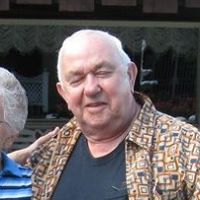Charles W Deyoe
age ~92
from Manhattan, KS
Charles Deyoe Phones & Addresses
- 1219 Meadowlark Vly, Manhattan, KS 66502 • 7855393519
- 2220 Browning Ave, Manhattan, KS 66502 • 7855393519
- Des Moines, IA
Lawyers & Attorneys

Charles Deyoe - Lawyer
view sourceISLN:
1000344526
Admitted:
2015
University:
McGeorge School of Law University of the Pacific, CA
Resumes

Charles Deyoe
view sourceEducation:
Ausablae Valley Central School 1941 - 1953

Charles Deyoe
view sourceUs Patents
-
Liquid Starch-Urea Ruminant Feed And Method Of Producing Same
view source -
US Patent:39884830, Oct 26, 1976
-
Filed:Sep 4, 1975
-
Appl. No.:5/610160
-
Inventors:Charles W. Deyoe - Manhattan KS
Erle E. Bartley - Manhattan KS -
Assignee:The Kansas State University Research Foundation - Manhattan KS
-
International Classification:A23K 100
A23K 122 -
US Classification:426 53
-
Abstract:A low-cost, highly nutritious starch-NPN liquid feed supplement and method of producing same is provided wherein the supplement exhibits markedly superior protein synthesis and growth-inducing properties as compared with conventional, unprocessed NPN-fortified supplements notwithstanding the fact that the supplements hereof generally have lower theoretical nutritive values than such prior feeds. The preparative method preferably includes the steps of passing an aqueous slurry of a starch-bearing food source and an NPN substance such as urea through a hydrothermal-type cooker along with direct steam for turbulently heating, disrupting and gelatinizing the starch source in the presence of the NPN substance to thereby yield a reacted product which can be fed to ruminants as a low-cost, high-protein food source. A wide variety of NPN substances can be employed in the supplements hereof, along with a large number of starch sources such as grains or industrial wastes such as starch-bearing food and beverage processing waste liquors. In addition, the liquid supplements hereof can be modified either before or after processing by adding energy sources such as molasses thereto.
-
Soymilk Process
view source -
US Patent:44092563, Oct 11, 1983
-
Filed:Mar 13, 1981
-
Appl. No.:6/249717
-
Inventors:Lawrence A. Johnson - College Station TX
William J. Hoover - Manhattan KS
Charles W. Deyoe - Manhattan KS -
Assignee:The Edlong Corporation - Elk Grove Village IL
-
International Classification:A23L 120
A23L 238 -
US Classification:426598
-
Abstract:This invention relates to a process for making a soybean-based milk analog or soymilk and food products prepared therefrom. The process involves the comminuting of whole soybeans having the hulls thereon, forming a slurry of the comminuted soybeans, simultaneously initiating the inactivation of trypsin inhibitor and lipoxygenase without fixing protein bodies or substantially denaturing the soybean protein, confining the heated slurry until the trypsin inhibitor activity is reduced to a desired value, cooling the slurry, and separating the hulls from the slurry to recover the desired product. The resulting soymilk is an aqueous preparation of the soybean which exhibits minimal destruction of essential amino acids, enhanced nutritional value, maximal retention, and thus increased yield of soybean solids including lipid and protein, optimal inactivation of trypsin inhibitors, reduced chemical browning, and enhanced flavor and palatability along with prolonged storage life. The process is characterized by the instantaneous heat transfer through direct infusion of steam into the slurry.
-
Salts Of 6-O-Acyl Ascorbic Acid For Yeast-Raised Baked Products
view source -
US Patent:40441547, Aug 23, 1977
-
Filed:Nov 17, 1975
-
Appl. No.:5/632353
-
Inventors:Russell C. Hoseney - Manhattan KS
Paul A. Seib - Manhattan KS
Charles W. Deyoe - Manhattan KS -
Assignee:The Kansas State University Research Foundation - Manhattan KS
-
International Classification:A21D 214
-
US Classification:426 21
-
Abstract:Salts of ascorbic acid 6-acylates (both the D-isoascorbic and L-ascorbic isomers) are provided which have significant utility as multi-functional, easily dispersible additives for yeast-leavened doughs or batters and serve as biologically active sources of vitamin C even when added to the dough or batter during preparation thereof and subjected to baking or frying temperatures. The additives hereof are also functional as dough conditioners, anti-staling agents, and shortening sparing agents, and also serve to maintain or even enhance loaf volume in resultant breads and the like and permit incorporation of protein supplements such as soy flour into such products without deleteriously affecting desirable organoleptic properties thereof. The 6-O-acyl ascorbate salts of the invention are compounds of the formula ##STR1## wherein M and Q are different and respectively taken fom the group consisting of --H and --OH, R represents an aliphatic group having from 12 to 18 carbon atoms, inclusive, and X is a salt-forming member selected from the group consisting of sodium, potassium, calcium and magnesium. A method of synthesizing the above acyl ester salts is also provided which includes the step of reacting the free acid form of the ester with a stoichiometric quantity of a base taken from the group consisting of the sodium, potassium, calcium and magnesium compounds of (1) an acid that is a weaker acid than the ester, and (2) an acid which can be removed from the reaction mixture by volatilization.
-
Method Of Preparation Of 2-Phosphate Esters Of Ascorbic Acid
view source -
US Patent:41794451, Dec 18, 1979
-
Filed:Jun 1, 1978
-
Appl. No.:5/911669
-
Inventors:Paul A. Sieb - Manhattan KS
Charles W. Deyoe - Manhattan KS
Russell C. Hoseney - Manhattan KS -
Assignee:Kansas State University Research Foundation - Manhattan KS
-
International Classification:C07F 909
-
US Classification:2603409R
-
Abstract:A method of preparing nutritionally useful 2-phosphated ester derivatives of ascorbic acid in extremely high yields is disclosed which includes steps of reacting an ascorbic acid such as L-ascorbic acid or a derivative such as 5,6-O-isopropylidene-L-ascorbic acid with a phosphorylating agent in the presence of a tertiary amine while maintaining the pH of the reaction mixture at a level of at least about 8 for achieving almost quantitative 2-phosphorylation of the ascorbic acid derivative. In preferred forms 5,6-O-isopropylidene-L-ascorbic acid is reacted in water with phosphorous oxychloride in the presence of about a fivefold excess of pyridine relative to the acid and at low temperatures (-5 to +5. degree. C. ); an alkali metal hydroxide such as potassium hydroxide is added to the reaction mixture as needed for maintaining the pH thereof at a level of about 12-13 during the entire phosphorylation reaction. Production of the diester of the ascorbic acid derivative can be selectively increased by omitting the tertiary amine from the reaction mixture and conducting the reactant at an elevated temperature of from about 30. degree. -60. degree. C.
-
Preparation Of L-Ascorbate 2-Sulfate From L-Ascorbic Acid
view source -
US Patent:39548090, May 4, 1976
-
Filed:Jan 22, 1973
-
Appl. No.:5/325652
-
Inventors:Charles W. Deyoe - Manhattan KS
Paul A. Seib - Manhattan KS
R. Carl Hoseney - Manhattan KS -
Assignee:Kansas State University Research Foundation - Manhattan KS
-
International Classification:C07D30762
-
US Classification:2603437
-
Abstract:A method is provided for the synthesis of L-ascorbate 2-sulfate compounds and salts thereof which comprises reacting L-ascorbic acid or the salts thereof of the formula ##EQU1## WHERE Z represents hydrogen or a cation capable of bonding with L-ascorbic acid, and n. sub. 1 is the valence of Z, with a base-sulfur trioxide complex of the formula ##EQU2## where A represents a tertiary amine, tertiary amide, ether or thioether, the reaction being carried out in a compatible solvent and in the presence of sufficient base to render the C. sub. 2 hydroxyl of the L-ascorbic acid more ionized than the C. sub. 5 and C. sub. 6 hydroxyls thereof. The process effects quantitative conversion of L-ascorbic acid to L-ascorbate 2-sulfate, and pure compounds of the latter are isolated in good yields. Such compounds have been found to act as stable vitamin C sources in food systems or the like.
-
Liquid Starch-Urea Ruminant Feed And Method Of Preparing Same
view source -
US Patent:42320461, Nov 4, 1980
-
Filed:Oct 16, 1978
-
Appl. No.:5/951617
-
Inventors:Charles W. Deyoe - Manhattan KS
Erle E. Bartley - Manhattan KS -
Assignee:Kansas State University Research Foundation - Manhattan KS
-
International Classification:A23K 122
-
US Classification:426 69
-
Abstract:A low cost, high capacity method for making starch-NPN liquid feed supplements is provided wherein a substantially NPN-free slurry containing water and a starch source is treated under high temperatures and pressures to gelatinize the starch component. After gelatinization, an NPN substance such as urea is added and thoroughly mixed with the slurry to produce a final feed. The cooking step may be advantageously performed indirectly using a tube and shell heat exchanger, or alternatively in a direct steam injection jet cooker. A wide variety of NPN substances can be employed in the supplements hereof, along with a large number of starch sources such as grains or industrial wastes. In addition, the liquid supplements can be modified either before or after processing by adding energy sources such as molasses thereto.

Charles Deyoe
view source
Charles M Deyoe Jr
view source
Charles Deyoe
view source
Charles DeYoe
view source
Charles Deyoe
view sourceYoutube
Classmates

Charles Deyoe
view sourceSchools:
Au Sable Forks High School Au Sable Forks NY 1977-1981
Community:
Cindy Robare, Faron Sawyer, Earl Taylor, Anna Hill, Matt Reynolds

Au Sable Forks High Schoo...
view sourceGraduates:
Charles Deyoe (1977-1981),
Patrica Miller (1948-1952),
Shelley Winter (1977-1981),
Ann Sprague (1990-1994)
Patrica Miller (1948-1952),
Shelley Winter (1977-1981),
Ann Sprague (1990-1994)
Googleplus

Charles Deyoe

Charles Deyoe
Get Report for Charles W Deyoe from Manhattan, KS, age ~92





